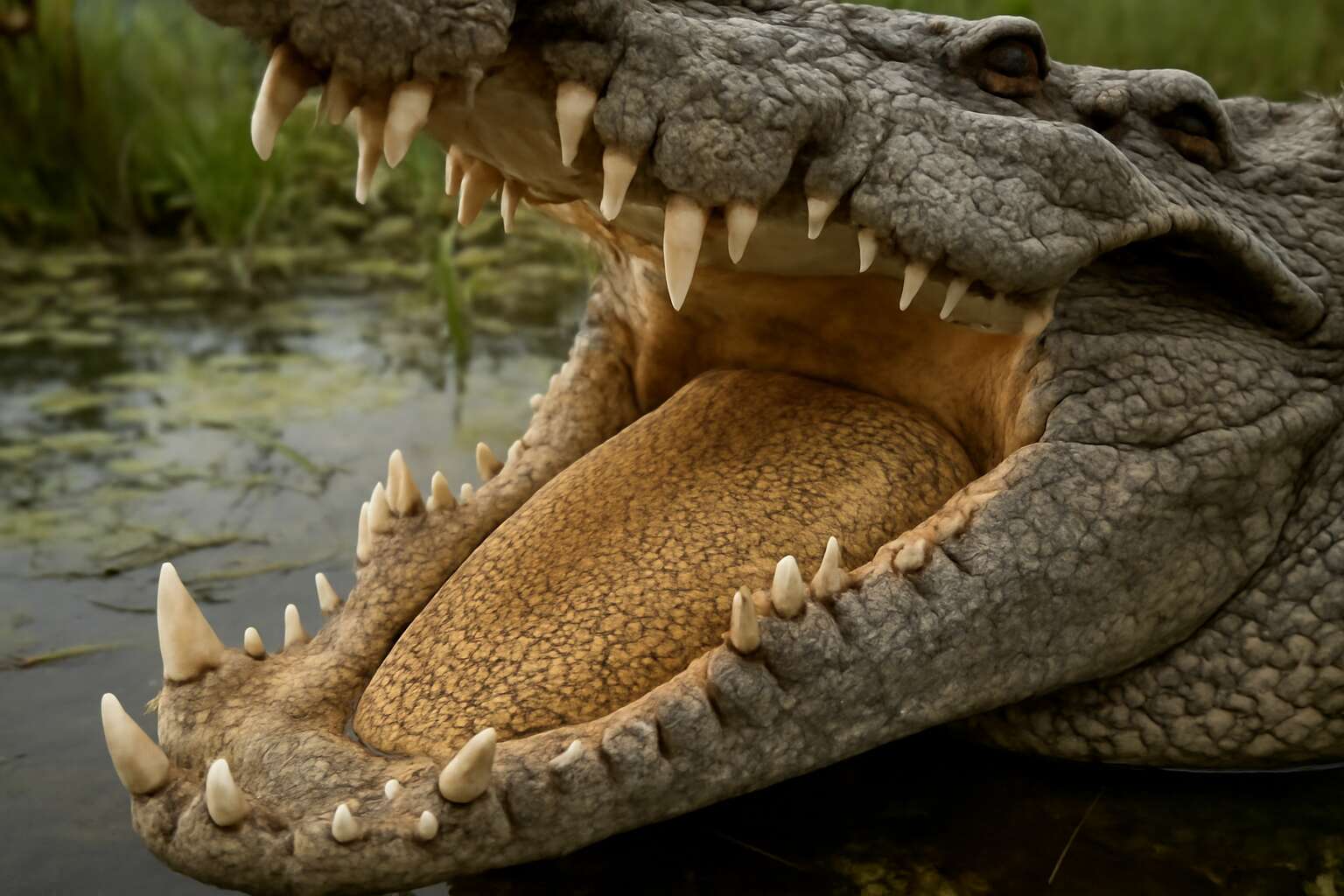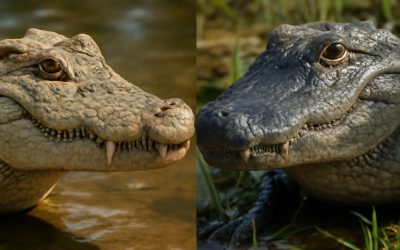Anatomy of Crocodiles: Understanding Their Mouth and Tongue
Overview of Crocodile Skull and Mouth Structure
When pondering the anatomy of crocodiles, one might instinctively wonder, “do crocodile have tongue?” This question sparks a fascinating exploration into their unique skeletal and muscular structure. Unlike many reptiles, crocodiles possess a partially developed tongue that plays a subtle yet vital role in their survival. Their mouth is a marvel of evolutionary engineering, with a robust skull designed for power and precision. The palate and jaw structure work in harmony, enabling them to catch prey with astonishing efficiency.
Interestingly, the crocodile’s tongue is relatively immobile and is often held against the roof of their mouth by a membrane, preventing it from protruding freely. This specialised feature allows them to keep their mouth open underwater without choking on water or debris. To better understand, consider the following points about their mouth and tongue structure:
- The tongue is anchored by a membrane, limiting its movement.
- Most of the crocodile’s tongue is attached to the floor of the mouth, reducing its mobility.
- This adaptation helps streamline their hunting strategy and enhances their ability to swallow prey whole.
In essence, the question of whether do crocodile have tongue reveals a creature perfectly adapted to its environment—one where form meets function in the most intriguing way. Their mouth, a testament to nature’s ingenuity, underscores how even the simplest questions can unveil profound insights into the marvels of evolution.
The Role of the Tongue in Reptiles
The anatomy of crocodiles reveals a creature finely tuned for survival, with every part of its body serving a purpose. When considering the question, “do crocodile have tongue,” it’s fascinating to explore how their oral structures are uniquely adapted. Unlike many reptiles, crocodile tongues are not as mobile or prominent as those of mammals, yet they hold a crucial role in their ecology.
The role of the tongue in reptiles generally centres around aiding in swallowing and sensory perception. In crocodiles, the tongue is relatively short and firmly anchored to the floor of the mouth by a membrane. This design prevents the tongue from protruding freely, which is a remarkable adaptation for their aquatic lifestyle. During hunting, this feature helps streamline their mouth, allowing them to catch prey efficiently without water or debris interfering.
Understanding the anatomy of crocodiles’ mouths and their tongues provides a window into their extraordinary evolution. Their specialised oral structures, including:
- the immobile tongue
- the sturdy jaw and palate design
highlight how these creatures are perfectly built for both power and precision in their environment. So, when asking, “do crocodile have tongue,” the answer lies in a creature’s incredible ability to adapt its anatomy, ensuring its place at the top of the food chain for millions of years.
Differences Between Crocodiles and Other Crocodilians
The anatomy of crocodiles reveals a fascinating tapestry of evolutionary mastery, where every feature serves a purpose in their relentless survival. When pondering, “do crocodile have tongue,” the answer unveils a creature whose oral architecture is both cunning and efficient. Unlike mammals, crocodiles possess a tongue that is relatively immobile, tightly anchored to the floor of their mouth by a strong membrane. This adaptation is no accident; it ensures their streamlined profile during aquatic pursuits, allowing them to ambush prey with silent precision.
Understanding the differences between crocodiles and other crocodilians enhances our appreciation of their specialised design. For instance, crocodiles boast a more robust jaw structure, complemented by a palate engineered for power, while their tongues remain largely stationary. This contrasts with the more flexible tongues of some lizards and snakes, which are vital for sensory exploration. In crocodiles, the immobility of the tongue exemplifies an evolutionary shift towards a focus on bite strength and aquatic camouflage.
Does a Crocodile Have a Tongue?
The Presence of a Tongue in Crocodiles
In the silent depths of the swamp, where predators reign supreme, a question often whispers through the shadows: do crocodiles have tongues? The answer reveals a startling truth—yes, they do, but their tongues are unlike the flexible, movable appendages humans are familiar with. Instead, crocodile tongues are embedded deeply within their mouths, anchored by a membrane that limits their mobility. This design isn’t a flaw but a calculated adaptation—one that ensures their survival in the treacherous waters they dominate.
This immobility serves a critical function, acting as a barrier to prevent water and debris from entering their throats during submerged ambushes. The crocodile’s tongue, although seemingly passive, is a silent guardian—protecting the airway and maintaining the integrity of their hunting apparatus. It’s a reminder that even the most seemingly simple anatomy can carry profound evolutionary wisdom, shaping the predator’s capacity for stealth and resilience.
Physical Characteristics of the Crocodile Tongue
When contemplating the formidable visage of the crocodile, one might assume that such ancient predators possess a highly mobile tongue, akin to that of mammals. Yet, the reality is far more intriguing. The question, do crocodile have tongue, reveals a silent marvel of evolution—an organ that is surprisingly static, yet vital. Embedded deeply within their massive jaws, the crocodile’s tongue is not a flexible, flicking appendage but a rigid structure tightly anchored by a membrane.
This unique physical characteristic ensures that the crocodile’s tongue acts as a steadfast barrier during their stealthy ambushes beneath the water’s surface. It effectively prevents water and debris from entering the throat, aiding in their survival during prolonged submerged pursuits. Unlike the tongues of many reptiles, which can be extended or retracted with ease, the crocodile’s tongue remains largely immobile, serving as a silent guardian within the confines of their formidable mouth.
Comparison with Other Reptilian Tastes and Mouth Structures
When pondering the enigmatic nature of crocodiles, a question often surfaces: do crocodiles have tongue? This query reveals more than a simple anatomical curiosity; it touches upon the profound adaptations that make these ancient predators so uniquely formidable. Unlike many reptiles, whose tongues are flexible and serve as vital tools for sensory perception and prey capture, the crocodile’s tongue is remarkably different.
In stark contrast to the active, flicking tongues of lizards or snakes, the crocodile’s tongue is largely immobile, firmly anchored within its expansive jaws. This physical trait isn’t accidental but an evolutionary marvel—designed to serve a specific purpose during their stealthy aquatic ambushes. Their tongue acts as a steadfast barrier, preventing water and debris from entering the throat during prolonged submersion, a crucial feature for survival in their aquatic habitats.
Considering other reptilian species, the differences are stark. For example, monitor lizards and geckos have tongues that extend and retract easily, aiding in hunting and environmental sensing. These adaptations highlight the contrast with the crocodile’s static tongue, which, despite its rigidity, plays a silent yet vital role in their predatory mastery. Such distinctions underscore the diverse evolutionary paths reptiles have taken—each tailored to their ecological niches and survival strategies.
Function of the Crocodile’s Tongue
Capabilities and Limitations
Many assume that crocodiles possess a fully functional tongue, but the truth is far more intriguing. The capabilities of a crocodile’s tongue are surprisingly limited, yet they play a critical role in their survival. Unlike mammals, a crocodile’s tongue is largely immobile, fused to the roof of its mouth, preventing it from moving freely. This physical trait is an evolutionary adaptation that ensures the tongue doesn’t interfere when the crocodile is capturing or swallowing prey.
While some believe that the crocodile’s tongue might have sensory functions, it’s mostly inert, offering little in the way of taste or manipulation. Interestingly, the question of do crocodile have tongue is often linked to their biting power and feeding strategy. Their formidable jaws do most of the work, rendering the tongue’s role quite limited. Instead, crocodiles rely heavily on their robust teeth and keen eyesight to hunt, with the tongue serving more as a stabilising feature than a sensory organ.
Understanding the function of the crocodile’s tongue reveals the creature’s remarkable evolutionary path. It’s a testament to how specialised adaptations—like a fused, immovable tongue—can optimise a predator’s efficiency. So, when pondering whether do crocodile have tongue, the answer is yes, but it’s not the versatile organ seen in other animals. Instead, it’s a specialised, immobilised structure that underscores the crocodile’s predatory prowess!
Role in Feeding and Food Manipulation
When pondering whether crocodiles have tongues, it’s tempting to imagine a creature equipped with a versatile organ akin to that of mammals. Yet, the reality reveals a different story—one rooted in evolutionary efficiency rather than complexity. The role of the crocodile’s tongue in feeding and food manipulation is surprisingly limited, but it’s no less fascinating in its specialised function.
Unlike mammals, the crocodile’s tongue is fused to the roof of its mouth, rendering it immobile. This adaptation ensures that during the violent act of biting and swallowing, the tongue remains out of the way, preventing interference. Instead of manipulating prey with their tongues, crocodiles rely heavily on their formidable jaws and razor-sharp teeth. The immobility of their tongue allows for a streamlined process—swift, decisive, and efficient.
In fact, the limited role of the crocodile’s tongue is complemented by a few key functions:
- Supporting the stability of the prey during initial capture
- Preventing debris from entering the throat during feeding
- Providing a structural anchor within the mouth that enhances bite force
This specialised structure signifies a profound evolutionary realignment—maximising predatory prowess while sacrificing versatility in food manipulation. The question of do crocodile have tongue is answered with a resounding yes, but it’s a tongue that embodies the brutal elegance of survival, rather than the dexterity of a mammalian organ. It’s a reminder that sometimes, less is infinitely more when it comes to evolutionary design.
Additional Functions in Crocodile Behavior
The function of the crocodile’s tongue extends beyond simple anatomy; it offers a glimpse into the creature’s behavioural nuances and survival strategies. While often dismissed as a minor feature, the tongue plays a subtle yet significant role in their daily existence. For instance, it helps in maintaining oral hygiene by preventing debris from entering the throat—an essential function for such a voracious predator.
In addition, the crocodile’s tongue aids in stabilising prey during the initial capture. This is crucial when dealing with large, struggling animals, ensuring the prey remains secure before the killing bite. Interestingly, the immobility of their tongue—fused to the roof of the mouth—shifts the focus entirely to their formidable jaws and teeth. Nevertheless, this structural adaptation serves other behavioural functions:
- Supporting the stability of prey during initial capture
- Preventing debris from entering the throat during feeding
- Providing a structural anchor within the mouth that enhances bite force
Understanding whether do crocodile have tongue is a question that reveals more about their behavioural intricacies than their anatomy alone. It’s a stark reminder that in the natural world, survival often hinges on efficiency rather than versatility—where the mute, fused tongue embodies the brutal elegance of evolutionary adaptation.
How Crocodile Tongue Composition Differs from Other Reptiles
Anatomical Variations Among Reptiles
Contrary to popular belief, the question “do crocodile have tongue” often sparks curiosity because their tongues are quite unlike those of other reptiles. While many reptiles sport a mobile, fleshy tongue capable of tasting and manipulating food, crocodiles possess a more specialised structure—one that’s firmly anchored to the roof of their mouth. This anatomical variation is a fascinating departure from the typical reptilian tongue, which often extends freely and aids in prey detection.
In the grand reptile kingdom, tongues are as diverse as their habitats. Crocodile tongues are essentially a rigid, non-protrusive flap — a feature that sets them apart from lizards and snakes, which frequently have highly mobile and sensory-rich tongues. This evolutionary tweak means crocodiles rely less on tongue-based exploration and more on their exceptional jaw strength and sensory scales to hunt and process food. Interestingly, this anatomical difference underscores the specialized feeding strategies that crocodiles have developed over millions of years.
- Unlike many other reptiles, crocodiles do not use their tongues for tasting or tasting-related activities.
- Their tongue’s primary function is to stay snugly pressed against the palate, preventing water from entering their respiratory pathways when submerged.
- This adaptation highlights a key difference in how crocodiles and other reptiles have evolved their mouth structures for survival.
Unique Features of Crocodile Tongues
When pondering the question, “do crocodile have tongue,” it’s easy to envision a classic reptilian feature—long, forked, and agile. However, the truth is far more intriguing! Unlike their snake and lizard cousins, crocodile tongues are a far cry from the flexible, taste-bud laden appendages we might imagine. Instead, they boast a specialised, almost comical structure—rigid, immovable, and firmly anchored to the roof of their mouths.
What makes the crocodile tongue a fascinating study in evolutionary adaptation? For starters, it lacks the sensory richness that characterises many other reptiles. Instead of helping them explore or taste their environment, the crocodile tongue’s primary role is to act as a barrier—pressing against the palate to prevent water from entering their respiratory pathways when they’re submerged in aquatic ambush tactics. This unique feature highlights how crocodiles have refined their mouth architecture for survival rather than exploration.
- It’s a non-protrusive, stiff flap—meaning they don’t flick it out like a lizard’s tongue.
- Its main function is to seal the mouth during water dives, not tasting or manipulating food.
- Unlike many reptiles, crocodile tongues are a testament to their specialised aquatic hunting strategy.
Evolutionary Aspects
In the grand theatre of evolution, the crocodile’s tongue stands as a silent testament to specialised adaptation. Unlike the versatile, sensory-rich tongues of many reptiles, the crocodile’s oral appendage is a hardened, immobile structure—an evolutionary masterpiece designed not for exploration, but for function. This stark divergence raises the question: do crocodile have tongue in the traditional sense? The answer is both fascinating and revealing about their survival strategy.
What sets the composition of the crocodile’s tongue apart from other reptiles is its rigid, almost stone-like constitution. While lizards and snakes often possess flexible, highly innervated tongues equipped with taste buds, the crocodile’s tongue is a staunch barrier, fused to the roof of their mouth. This anatomical distinction underscores a pivotal evolutionary shift—prioritising aquatic efficiency over tactile or gustatory exploration. The crocodile’s tongue is not a tool for tasting but a specialised feature that complements their predatory prowess in murky waters.
- In contrast to the delicate, movable tongues of many reptiles, the crocodile’s tongue is a fixed, immovable flap.
- This structural difference exemplifies a broader evolutionary theme: adaptation for specialised feeding strategies.
Through this lens, we see how the composition of the crocodile’s tongue exemplifies a remarkable evolutionary divergence—one that emphasises survival over sensory exploration. Understanding these nuances deepens our appreciation for how nature crafts intricate, purpose-built structures in its relentless pursuit of mastery over the environment. So, when pondering, “do crocodile have tongue,” we uncover not just a simple anatomical fact, but a story of evolutionary ingenuity etched into their very mouths.
Misconceptions About Crocodile Tongues
Common Myths Debunked
Many believe that crocodiles, with their fierce reputation, possess a tongue similar to that of mammals. However, this is a common misconception rooted in visual similarity rather than anatomical truth. In reality, the answer to “do crocodiles have tongue” is more complex, revealing a fascinating divergence from what many instinctively assume.
Contrary to popular belief, the crocodile’s tongue is relatively immobile and often constricted by a membrane that anchors it to the mouth’s floor. This limits its functionality in the way human or mammalian tongues operate. Some myths suggest that crocodiles use their tongues to manipulate prey or enhance their sense of taste, but these notions are simply inaccurate.
Interestingly, the debate around “do crocodile have tongue” often neglects the specialised adaptations that enable these predators to thrive. Their mouth structure, for example, is designed more for force and stealth rather than tactile or taste-related functions. So, while the question persists, the reality remains clear: crocodiles have a tongue, but it plays a far less dynamic role than in other animals, challenging our assumptions about their behaviour and physiology.
Scientific Evidence and Observations
The myth that crocodiles possess a flexible, mammal-like tongue persists despite overwhelming scientific evidence to the contrary. Many assume that because of their impressive bite force and predatory prowess, their tongues must also play an active role in prey manipulation. Yet, when we scrutinise their anatomy, the truth is far less glamorous. The question “do crocodile have tongue” often sparks lively debate, but the reality reveals a rather static and constrained structure.
Scientific observations consistently demonstrate that the crocodile’s tongue is almost immobile, tethered tightly to the mouth’s floor by a thick membrane. Unlike mammals, which use their tongues for taste, speech, or tactile exploration, crocodile tongues are primarily a structural feature—more of a passive anchor than a versatile organ. This misconception is further compounded by visual similarities, but the anatomical evidence makes clear that their tongues lack the dexterity or sensory capacity found in other creatures.
In fact, the evidence suggests that the crocodile’s mouth is optimised for forceful bites and stealth rather than for manipulating prey with a tongue. The limited mobility of their tongue means it plays a negligible role in food processing or tasting. Instead, crocodiles rely heavily on their powerful jaws and keen senses of sight and smell. So, when pondering “do crocodile have tongue,” it’s essential to recognise that their tongue is more a vestigial remnant than a functional marvel—an anatomical curiosity that challenges our instinctive assumptions about these ancient predators.
Importance of Accurate Understanding in Conservation
Misconceptions about crocodile tongues can have far-reaching consequences, especially in conservation efforts. Many people still believe that crocodiles possess a flexible, mammal-like tongue that aids in prey manipulation. This myth perpetuates a false sense of complexity about these ancient creatures and may lead to misunderstandings about their behaviour and needs.
Understanding the simple, almost static nature of the crocodile’s tongue is crucial. It highlights how these animals are specialised for forceful bites and stealth rather than oral dexterity. When discussing whether “do crocodile have tongue,” it’s vital to clarify that their tongues are more vestigial than functional.
Misconceptions like these can distort public perception and undermine conservation initiatives. Accurate knowledge about their anatomy helps foster respect for their true biological adaptations, which are often misunderstood. Recognising that the crocodile’s tongue is a passive, immobile structure reinforces the importance of protecting these predators in their natural habitats, free from myths that oversimplify their complex evolutionary legacy.
Interesting Facts About Crocodile Mouths and Tongues
Surprising Adaptations
Contrary to popular belief, the question of whether crocodiles have a tongue is more complex than it appears. While many assume that these ancient predators possess a fully functional, mobile tongue like mammals, the reality is quite different. In fact, the crocodile’s tongue is firmly anchored to the roof of its mouth by a membrane, limiting its movement significantly. This adaptation may seem peculiar, but it plays a crucial role in their survival strategies.
Surprising as it may be, the crocodile’s tongue is primarily used to create a seal within the mouth, aiding in breathing and preventing water from entering the respiratory passages during submersion. Unlike mammals, their tongues lack the muscular agility to manipulate food or assist in tasting. Instead, crocodiles rely heavily on their keen senses and powerful jaws for hunting. This specialised adaptation raises the question: do crocodile have tongue, or is it more of a structural feature than an organ of sensation? The answer reveals the marvels of reptilian evolution and their unique approach to survival in aquatic environments.
Unique Behavior Patterns
The crocodile’s formidable reputation is built on its powerful jaws and stealthy hunting tactics, but the question of whether do crocodile have tongue remains one of the most intriguing mysteries of reptilian anatomy. Unlike mammals, their mouths are a marvel of specialised structures, designed for efficiency rather than sensation. The answer reveals a fascinating glimpse into evolutionary adaptation—crocodiles’ tongues are largely immobile, anchored firmly to the roof of their mouths by a membrane. This configuration limits movement but serves a vital purpose.
Interestingly, the crocodile’s tongue acts more like a sealing device than an organ of taste or manipulation. During submersion, it helps create a watertight seal that aids in breathing and prevents water from flooding the respiratory passages. Among crocodilian behaviour patterns, this adaptation underscores their mastery of aquatic survival. They rely heavily on their acute senses and robust jaws rather than their tongues for hunting or food processing.
- They use their tongues primarily to block water intake during underwater ambushes.
- Their limited tongue mobility means they cannot manipulate objects or taste in the way mammals do.
- Despite its apparent simplicity, the tongue’s structural role is crucial for their aquatic lifestyle.
In the grand tapestry of reptilian evolution, the crocodile’s tongue exemplifies how form follows function in the most extraordinary ways. So, when contemplating do crocodile have tongue, it becomes clear that their tongues are less about sensation and more about survival—an elegant testament to nature’s ingenuity.
Impact on Crocodile Survival and Hunting
When pondering the mysterious intricacies of crocodilian anatomy, a curious question often emerges: do crocodile have tongue? The answer might surprise you. Unlike mammals, whose tongues are flexible tools of taste and manipulation, the crocodile’s tongue is more of a static, specialised structure—designed for one critical purpose: survival. Their tongues are immobile, anchored firmly to the roof of their mouths by a membrane, which sounds less like a culinary organ and more like a natural engineering marvel.
This adaptation serves as a vital survival feature, especially during aquatic ambushes. When lurking beneath the water’s surface, crocodiles use their tongues primarily to block out water intake, creating a watertight seal that allows for breathing without flooding their respiratory passages. To put it simply, their tongues act like efficient, built-in water dams, showcasing evolution’s knack for functional elegance. So, when asking do crocodile have tongue, the answer becomes clear: it’s less about sensation and more about strategic survival, proving once again that nature’s designs often defy expectations.
- They use their tongues to create a watertight seal during underwater hunts.
- Their limited mobility means they can’t manipulate objects or taste in a mammalian sense.
- This structural feature is central to their aquatic dominance and hunting efficiency.




0 Comments